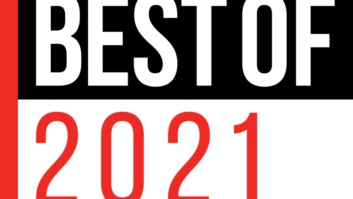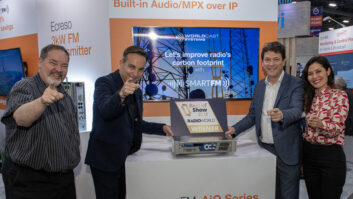The path of Best Conductance
Feb 1, 2002 12:00 PM, By Chriss Scherer, editor

One of the most important equipment selection decisions made when building a facility is also one that is typically given the least thought. The wire and cable used to connect everything within the facility is an important element. It is a part of the overall circuit path. The wire choice is often made without really considering the vital role it plays in the facility’s operation.
Simply put, not all wire is the same. Some manufacturers (particularly on the consumer side) insist that the overpriced, supposedly special-formula copper blend is better for a particular application. There are variations in manufacturing quality, but more importantly, there are electrical differences to consider. A cable’s impedance, capacitance and immunity to unwanted signals are important in any application.
Basic considerations
The physical design is the first consideration. The conductors can be either solid or stranded. Both offer certain advantages. Stranded wire should be used any time the cable will be flexed in any way. Solid-conductor wire should only be used when the wire will not move. This said, it is very common to use stranded wire in fixed installations, such as a studio interconnect.
The 66-style telephone punch blocks are still regularly used in facilities. These blocks were designed for use with solid wire. They will work with stranded wire if the terminations are carefully made. Uninsulated shield or drain wires should be covered with tubing to prevent the individual strands from coming loose. Because of the tapered opening, stranded wire tends to push out of the punch terminal.
Newer block styles, such as those from Krone and Bix, work well with either type of wire because the forked terminal is parallel and does not taper.
Microphone cables are prone to excessive flexing, so use stranded wire. In addition, a rugged, flexible jacket is important. Some microphone cables also have additional filler to add strength and reduce stress from cable tension.
A foil shield offers complete coverage and is easy to prepare for a connector.

Also keep in mind that microphones are low-level devices. The cable used between the mic and the preamp should provide the highest immunity to noise and interference. Avoid using fixed-installation wire for microphones because some types of this wire typically are microphonic. As the wire is moved or touched, it will mechanically pick up the vibration and result in unwanted pops in the audio feed.
When two or more conductors share a common jacket, particularly two wires in a balanced signal application, an outer shield may be used, especially for most audio applications. A braided shield is very flexible and adds additional strength to the cable, but a braided shield can be difficult to work with when attaching a connector. Also, a braided shield does not completely shield the inner conductors. A second braided shield will improve overall shielding, but this likewise adds more tedium to connector assembly.
Connector preparation of a braided-shield cable does not have to be difficult. See an explanation of an easier method in the Engineer’s Notebook.
Fixed-installation cables often make use of a foil shield. A foil shield can provide 100 percent shield coverage, which makes it electrically favorable. An additional drain wire is added to the cable to carry the shield connection to the connector. If the wire is subject to any movement or flexing, the foil shield can become deformed, which lessens its effectiveness. While a shield can offer some rejection to unwanted noise, there is a better defense.
By twisting the two conductors, a cable increases its ability to reject external interference. To be most effective, the twist must be consistent through its path. The tightness of the twist is also important in improving the noise rejection ability. A tighter twist has a better specification.
A braided shield stands up to cable flexing and adds strength to a cable.

There is a variation on a twisted-pair cable that offers even better noise rejection properties. Star-quad mic cable (a term coined by Canare but not trademarked and now a generic term) is a four-conductor cable exhibiting very low noise and hum pickup. This is also called double-balanced cable.
Analog vs. digital
All wire has a characteristic impedance. Coaxial cables are specified by impedance. Analog audio and control wire has typically ignored the characteristic impedance. In most situations, the electrical characteristics are not important. For long analog wire runs, a lower capacitance value cable should used to prevent attenuation of the higher frequencies.
Digital signals ideally should be passed through a cable with constant, specific impedance. The AES-3 digital audio standard (balanced) calls for a characteristic impedance of 110O. The unbalanced version, AES-3ID, calls for 75O cable. For reference, common analog audio, shielded twisted pair cable has characteristic impedance of about 30O. Because digital audio cable is designed for a specific impedance, it tends to be more consistent throughout the entire section. You can pass digital audio over analog cable, and for short distances you may not have any difficulties. However, if only one type of cable can be used for an audio installation, digital audio cable would be a preferred choice. Digital audio cable is the best analog cable you can find.
Turn up the heat
There are several different ways to classify wire and cable, but one application-specific classification is plenum-rated cable. When cables are run in an air return space for ventilation, such as within a drop ceiling, electrical codes and fire codes may call for a plenum-rated cable. Materials commonly used for cable jackets, such as PVC, melt at high temperatures. Some also produce toxic gases when burned. During a fire, these toxic gases could be distributed through a building’s HVAC system. In these installations, a plenum-rated cable must be used. The most common material used for a plenum cable jacket is Teflon, but other materials can be employed.
Cables may contain additional filler material to maintain the spacing of the conductors or to provide additional strength.

Non plenum cables in a plenum space are an obvious target for building inspectors during construction. Once an inspector approves an installation, it is rare that you will see him again, and the temptation to use less expensive, non-plenum cable may need to be overcome. But building codes, electrical and good engineering practice dictate that this should never be done.
High-performance cable
The Telecommunications Industry Association and Electronics Industry Association have established a set of cable categories to describe certain characteristics of data cable performance. The TIA/EIA standards define categories 1 through 5 (CAT1 through CAT5) for unshielded twisted-pair cables (UTP).
- CAT1 is rated for 19.2kb/s;
- CAT2 is rated for 786kb/s;
- CAT3 is rated for 16Mb/s and is unshielded;
- CAT4 is rated for 16Mb/s and is shielded; and,
- CAT5 is rated for 100Mb/s, with additional levels, such as CAT5e, rated up to 400Mb/s
CAT6 and CAT7 are not yet officially TIA/EIA standards and not rated. Cables that are called CAT6 by manufacturers are typically rated at 350Mb/s; CAT7 is typically rated at 600Mb/s. A CAT7 standard is likely to be adopted, and it will probably be a shielded cable.
Twisted-pair data cables can also have a shield. These cables are referred to as shielded twisted-pair cables (STP).
Because of the proliferation of CAT5 cable for computer networks, other industries are finding uses for this cable. Digital audio is one of those uses. I previously noted that the AES-3 standard defines use with 110ohm; cable. This standard has a tolerance of +/-20 percent, resulting in a usable range of 88ohms to 132ohms. CAT5 cables and higher are specified at 100ohms +/-15 percent, resulting in a usable range of 85ohms to 115ohms. There is a significant overlap in the ranges of these two standards. Except for the minimum impedance rating range, it is obvious that the CAT5 cable standard is within the limits of the AES-3 audio standard. It has been shown in practice that CAT5 indeed works very well for AES-3 audio applications.
Plenum cable is rated to withstand high temperatures for use within an air-return space.

Coaxial cables are used for both data and RF signals. As mentioned earlier, the AES-3ID digital audio standard calls for 75ohm cable. The same handling, routing and connector considerations apply to coaxial cables as to twisted-pair cables.
A lighter load
Fiber optic cable is gaining popularity for intrafacility interconnection because of its small size and massive signal capacity. Fiber is already used for long distance connections, something for which it is well suited. Fiber optics are also impervious to electromagnetic interference. However, the cable is more delicate than its copper counterpart. Physical stress of any kind should be avoided. Likewise, any connectors or splices must be installed properly to prevent signal losses.
Most wire and cable manufacturers offer extensive resources to assist you in selecting the best cable for a particular need. Some post these resources online and in their catalogs. It’s easy to simply specifiy the same cable you have always used, but with improvements in design and electrical specifications constantly occurring, there likely is something better out there.
Photos courtesy of Belden Electronics and Gepco.
Working with UTP
When installing or moving data-rated cables, several basic practices should be followed to ensure maximum signal integrity.
Use the correct connectorsAny impedance mismatch will cause a signal error. Digital signals can handle small errors with few undesired effects. In time, enough signal problems will cause noticeable data errors. This rule also applies to coaxial cables.
Do not physically stress the cable with tension, hard bends, kinks or tight cable tiesPhysical stress to the cable will change its impedance or capacitance ratings. Any change in the transmission path will result in an error in the signal.
Space cable ties at irregular intervalsWhen cable ties are used, they will naturally deform the cable slightly. By spacing the ties at irregular intervals you avoid creating a problem at the wavelength relative to the spacing.
Maintain the twist as far as possible to the connector or terminationA cable’s twist and conductor spacing are an integral part of it signal rating capability. By maintaining the cable’s electrical parameters, you will ensure a higher level of signal integrity.
Marketplace
Manufacturers of wire and cable and wiring systems
Belden Wire and Cable
800-BELDEN1
fax 765-983-5294
www.belden.com
[email protected]
Bi-Tronics
800-666-0996
fax 800-569-4244
www.bi-tronics.com
[email protected]
Canare
818-365-2446
fax 818-365-3397
www.canare.com
[email protected]
Clark Wire & Cable
800-222-5348
fax 847-949-9595
www.clarkwc.com
[email protected]
DGS Pro Audio
800-292-2834
fax 817-561-2916
Ensemble Designs
530-478-1830
fax 530-478-1832
www.ensembledesigns.com
[email protected]
Gepco International
800-966-0069
fax 847-795-8770
www.gepco.com
[email protected]
Hosa Technology
714-736-9270
fax 714-522-4540
www.hosatech.com
[email protected]
Klotz AIS
+49 8106 3080
fax +49 8106 308101
www.klotz-ais.com
[email protected]
MIT (Mogami)
+81 3 3439 3755
fax +81 3 3439 3877
www.mogami-wire.co.jp
Mohawk/CDT
800-422-9961
fax 978-537-4358
www.mohawk-cdt.com
Nemal Electronics Int’l
800-522-2253
fax 305-895-8178
www.nemal.com
Radio Systems
856-467-8000
fax 856-467-3044
www.studiohub.com
[email protected]
Redco Audio
800-572-7280
fax 203-384-1239
www.redco.com
West Penn Wire
800-245-4964
fax 724-222-6420
Wireworks Corporation
800-642-9473
fax 908-686-0483
www.wireworks.com
[email protected]












